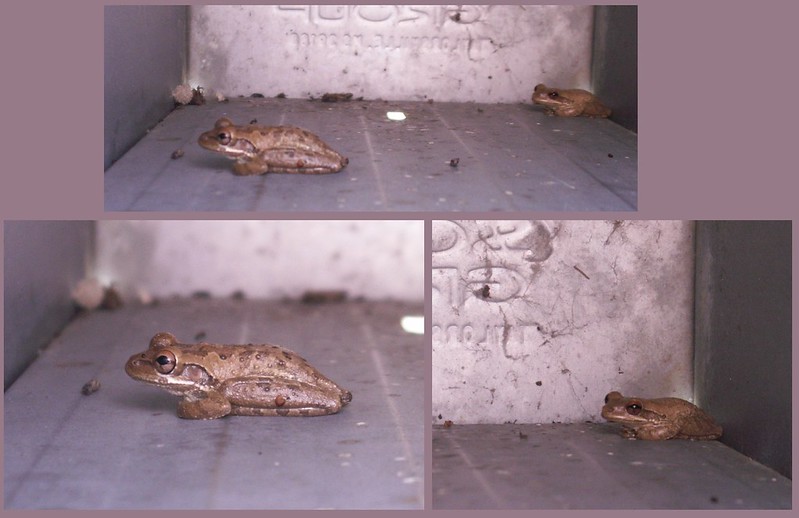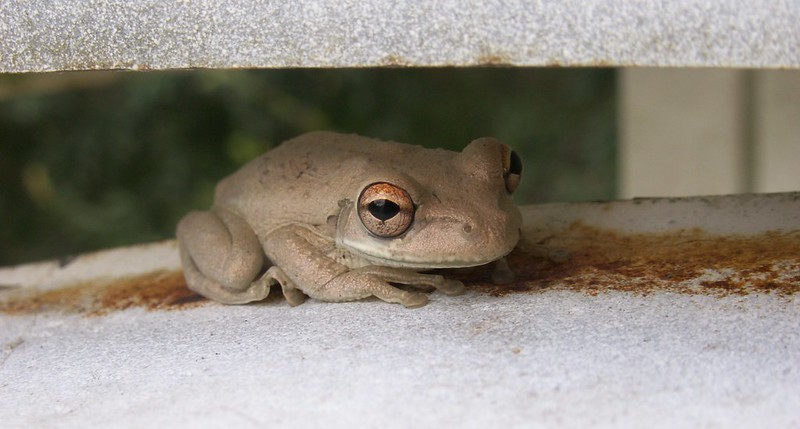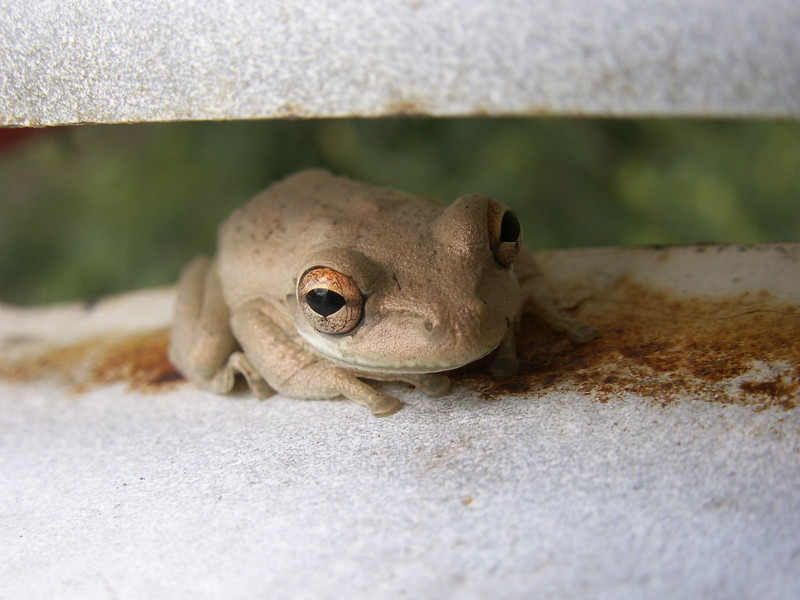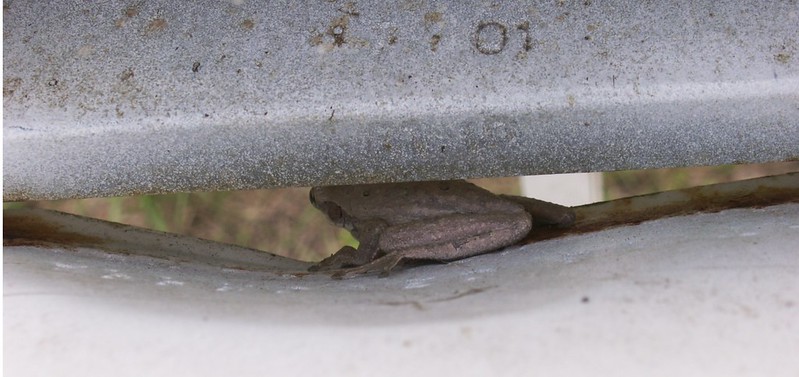Invaders (Most Likely)

Large
Unfortunately, I suspect these two are juvenile Cuban Treefrogs (Osteopilus septentrionalis), an invasive species. Indicators are their large eyes, warty skin, the white stripe on the frog at foreground left, and (as seen below) large toepads. I'm awaiting ID confirmation. Among other things, Cuban Treefrogs feed on this area's native frog population.
To give an idea of size, the inside width of my mailbox measures 5-3/4 inches.
These two individuals have taken up residence inside the mailbox. The above set of photos dates from September 30, and likely shows the same frogs that I had photographed on September 26, when I wondered if they were Squirrel Treefrogs.
The photos below date from October 4 and are of a single individual that had perched on the inside of the door when I opened it to get my mail. The second frog (not photographed today) was inside and at the back of the mailbox.

Large
According to the University of Florida, "Cuban Treefrog skin secretes a mucus that can irritate eyes and nose, cause allergy-like symptoms, and even trigger asthma attacks; they breed loudly after midnight in pools, ponds, birdbaths, etc.; they invade toilets and can clog drains; they invade power boxes and cause power outages."

Large
I started hearing the song of this species several months ago, first (it seemed) from across the street, then outside the house, and also around a nearby retention pond. I'm more accustomed to hearing Squirrel Treefrogs around the house.
Squirrel Treefrogs are native to this area, but they and other native species are being displaced by the Cuban Treefrogs. Unlike the frogs pictured here, native treefrogs are smooth-skinned.

Large
According to UF, Cuban Treefrogs are native to Cuba, the Cayman Islands, and the Bahamas. Their range has expanded throughout the Caribbean, in Hawaii, and in Florida, with a possible isolated population in southeastern Texas.

Large
According to Dr. Steve A. Johnson of UF's Institute of Food and Agricultural Sciences, "The first Cuban Treefrogs in Florida likely arrived as stowaways in shipping crates originating from the Caribbean. By the mid-1970s, they had dispersed throughout most of southern Florida. As of 2010, there appear to be established breeding populations as far north as Cedar Key on Florida's Gulf Coast, Jacksonville on the Atlantic Coast, and Gainesville in north-central Florida" ("The Cuban Treefrog (Osteopilus septentrionalis) in Florida") That northern boundary is about 60 miles north of the frogs photographed here.
Johnson continues, "A scientific paper published by German biologists in 2009 suggested that human-caused climate change may create conditions suitable for Cuban Treefrog colonization and breeding and allow this frog to become established across much of the southeastern U.S."
Compare the shot above with Johnson's figure showing the difference between the toepads of native treefrogs and those of the Cuban Treefrog. This UF photo of a Cuban Treefrog eating a Green Treefrog also shows the difference in toepad size.

Large
This one seems to be giving me the finger.
"Invasive Cuban Treefrogs eat a wide variety of food items, including snails, millipedes, spiders, and a vast array of insects," writes Johnson. "They are predators of several of Florida's native frogs, and are cannibalistic. They are also known to eat lizards and even small snakes. Fortunately, several species of native snakes will eat Cuban Treefrogs, including rat snakes, Black Racers, Pygmy Rattlesnakes, and Garter Snakes. Owls, crows, and wading birds have also been seen feeding on Cuban Treefrogs."
When I weed-whacked the yard last month I saw a Black Racer ribboning across my back porch -- far too quickly for me to photograph (let alone get my camera out). I did, however, manage to photograph this individual in 2007. Black Racers are beneficial. They prey on vermin, so I'm thrilled whenever I see one.
As for the birds Johnson mentions, we have plenty of crows in the neighborhood, along with seasonal wading birds (especially White Ibises and Cattle Egrets). Once in a great while I hear a Great Horned Owl.

Large
By this point I was crouching in the road, taking photographs from beneath my mailbox. I won't speculate on what, if anything, went through the minds of the couple of people who drove down my street at that time.
Johnson writes, "Cuban Treefrogs are the largest species of treefrog in Florida, and adult females may exceed 6 inches in length. Most Cuban Treefrogs, however, range from 1–4 inches long." Furthermore, "A very large female may lay in excess of 15,000 eggs in one season....Acceptable breeding sites include isolated wetlands, ditches, decorative ponds, and even swimming pools that are neglected. Cuban Treefrogs can breed in surprisingly small amounts of water. An old ice chest or child's wading pool half full of water are suitable nurseries for Cuban Treefrog tadpoles to develop into frogs."

Large
Unlike native treefrogs, which rarely enter houses, Cuban Treefrogs aren't shy. "Cuban Treefrogs can enter homes in a variety of ways," Johnson writes. "They may jump through open doors or windows, be brought into a house inadvertently on an ornamental plant, or get into a home's plumbing system through vent pipes on the roof. When Cuban Treefrogs gain access through vent pipes of a home plumbing system, they usually end up in a bathroom. There are numerous instances where unsuspecting people have opened the lid to their toilet only to find a bug-eyed Cuban Treefrog staring up at them." They can also get into transformer boxes and electrical switches and cause a short circuit.

Large
It's now clear to me that one way the frogs get into the mailbox is through a rather large gap between the hinged door and the box itself.
Johnson's article details ways to capture and humanely euthanize Cuban Treefrogs, but cautions the reader to be sure that they are indeed the invasive species and not a native treefrog. His lab has a Citizen Science page where frog ID can be confirmed and activities reported.













0 Comments:
Post a Comment
<< Home